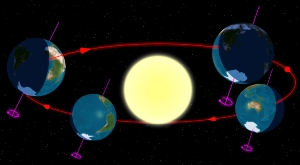Did you know that the South Pole sees only one day per year?
Amundsen arrived at the South Pole just a week shy of midsummer’s day. Or to be more precise: he arrived there almost in the middle of it.
 Diagram showing the Earth's seasons seen from the South. Far right: summer solstice. Illustration: Wikimedia Commons
Diagram showing the Earth's seasons seen from the South. Far right: summer solstice. Illustration: Wikimedia Commons
In 2011, midsummer comes to the South Pole on December 22, just like anywhere else on the Southern Hemisphere. But unlike anywhere else on the hemisphere, that date is also the middle of a very long day lasting exactly 6 months. The summer solstice marks the point of time when the sun will be heading down again for the first time since June.
To put it in physical terms, this happens because the rotational axis of the Earth is tilted in relation to the plane of the planet’s orbit around the sun. At summer solstice the Earth will be reaching the point in its orbit where the southern end of the rotational axis has its maximum inclination towards the sun. "The southern end of the rotational axis" is by definition the South Pole, so you might say that this is the day when the Pole points as much towards the sun as it will ever do during a year. As seen from the ground, the sun will culminate in its path across the sky, having reached an elevation of roughly 23,5 degrees above the horizon.
What is unusual about the Pole, is that the sun stays at that elevation the whole day. It does not rise in the morning, nor go down in the evening – it merely circles the horizon at the same elevation throughout the 24 hours. But from solstice day it will start a slow descent towards winter and obscurity, gradually spiralling down until it finally goes below the horizon in late March. That sunset, at the autumnal equinox, will be the only one at the South Pole next year. At other latitudes the equinox is when days and nights are equally long; at the South Pole it is when the day ends and the night begins. Sunrise comes 6 months later! On the North Pole the situation is completely reversed, so anyone sitting up there in December will be right in the middle of an equally long night.